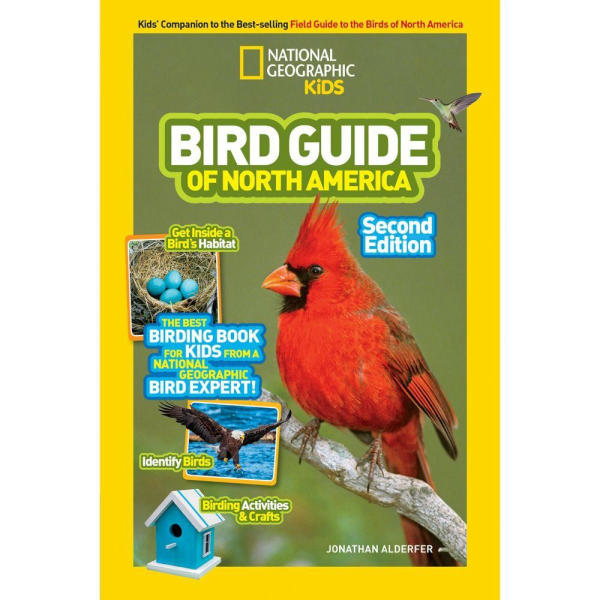
|
Birding is like going on a treasure hunt. That’s the pitch from author Jonathan Alderfer in his Bird Guide of North America, and I can’t think of a better way to introduce kids to birding. This National Geographic publication is a fun, engaging way to excite kids about birds, birding and bird identification. A warning to adults: You’ll really like it too!
This field guide simplifies identification by focusing on birds found in 10 common habitats, such as Eastern and Western Backyards, City Streets and Parks, Beach and Bay, and Western Mountains. Each of these sections begins with a short description of the habitat type, why it’s appealing to birds and where to look for birds in that habitat. Five common birds found in each habitat type are profiled, with two full pages devoted to each species, providing information about identification, voice, food, habitat and range. Colorful maps illustrate summer, winter, year-round and migration ranges. Each habitat type also includes a dozen mini-profiles on other species likely to be encountered.
Children will be drawn to special sections about Rock Star Birds (charismatic Snowy Owls and Painted Buntings), Birds Behaving Badly (Brown-headed Cowbirds laying eggs in the nests of other species, Mississippi Kites dive-bombing human trespassers near their nests) and Birds in Peril (featuring six simple things virtually any kid can do to help birds, such as preventing window collisions).
There are short sections about how to build a bird feeder and bird bath, and how to draw a bird. Drawing birds is a great way to learn more about them and, of course, basic drawing skills can be used to note field markings important for identification. These are also great activities for children to do with each other, or with parents or other adults.
As with adult field guides, but designed specifically for kids, there are sections on the identification process (becoming a bird detective), gear, clothing (hints like wearing bright colors may scare birds), and etiquette (playing by the rules so as not to disturb birds in nature).
There is a short but thoughtful section at the end of the book that directs children to other age-appropriate books, movies and websites. This information will come in handy when a youngster wants to learn more and keep exploring the sport of birding.
This is not a comprehensive field guide to the birds of North America. If your young birder is chomping at the bit to learn how to separate Northern Waterthrushes from Louisiana Waterthrushes, or tease apart birds in the Western Grebe complex, this book won’t help.
If, however, you know a youngster showing an interest in birds, or you are an adult looking for help introducing birds and birding to a child, I think you’ll find this book stimulating and helpful. The photos are stunning, the writing is engaging and the information is interesting. In fact, I wouldn’t hesitate to share this guide with a beginning adult birder. Yes, it’s written for kids, but it’s not a childish presentation. Teens will absorb the text and find the identification process intuitive. Younger novices will enjoy someone reading the text to them and following along with the photographs.
Sharing this National Geographic Kids Bird Guide of North America is a sure-fire way to stimulate interest in birds. If you don’t know any young birders, consider buying a copy or two of this book and donating it to the local library, nature center or school. You never know when a curious mind might come across it and launch a lifetime of birding.
Review by Peter Stangel